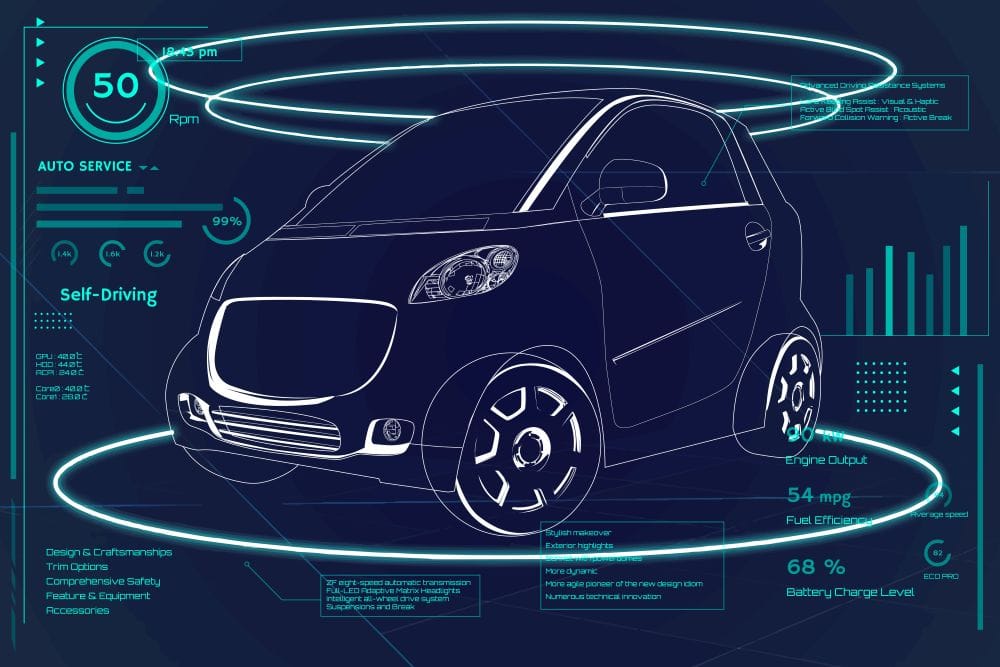Artificial Intelligence (AI) has become the engine behind a new era of smart mobility, redefining vehicle design, manufacturing, driving, and maintenance. According to the latest research by Statista, the global automotive AI market is expected to reach $1.01 trillion by 2031. Therefore, understanding the newest AI trends is crucial for automakers, tech companies, and consumers.
In this blog, we will explore the top AI trends in automotive industry for 2025, backed by the latest data, insights, and innovations.
Autonomous Driving
Leading tech and automotive companies like Waymo, Tesla, Cruise, and Baidu are operating commercial robotaxi services in cities such as San Francisco, Phoenix, and Shenzhen.
What is Autonomous Driving
Autonomous or self-driving cars rely on AI algorithms, machine learning, radar, lidar, GPS, and cameras to detect their surroundings, make driving decisions, and safely reach their destinations. There are five levels of automation, from level 0 (no automation) to level 5 (full automation under all conditions). In 2025, Level 4 autonomy, which allows fully driverless operation in controlled, geofenced areas, is actively being tested and partially deployed.
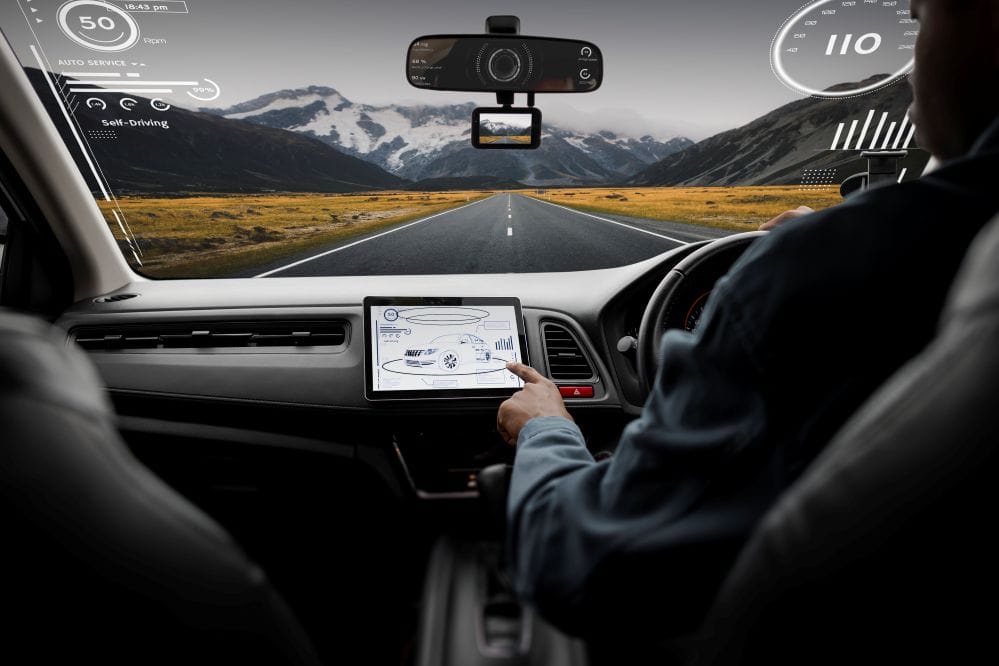
Top AI Trends in automotive vehicles
- AI-Powered Training: Autonomous systems are trained using reinforcement learning and simulated environments that cover millions of virtual miles. This helps vehicles learn complex driving behaviors.
- Edge AI for Real-Time Decisions: By integrating edge computing, vehicles can process data in real time, allowing faster and safer responses on the road.
- Tesla’s FSD Evolution: Tesla’s Full Self-Driving (FSD) software continues to improve with neural networks and can handle complex movements like roundabouts and unprotected left turns.
According to McKinsey, autonomous vehicles could reduce traffic accidents by up to 90%, primarily by removing human error from the equation. Beyond safety, robotaxis and self-driving cars promise increased convenience, accessibility, and lower transportation costs.
Predictive Maintenance
Predictive maintenance refers to using AI, machine learning, and sensor data to estimate a vehicle component’s potential failure. AI systems continuously monitor the functioning of vehicle systems, like the engine, transmission, brakes, and battery, to detect patterns that may signal future problems.
These systems collect data from different vehicle sensors (such as vibration, temperature, oil quality, and performance metrics) and compare them with historical failure records. This information is processed using cloud computing and AI-powered analytics to generate accurate, timely service alerts.

Benefits of Predictive Maintenance
- Increased Vehicle Uptime
Predictive maintenance reduces the risk of unexpected breakdowns, especially critical for fleets and commercial vehicles. - Lower Service Costs
Preventing major issues with early detection helps avoid expensive repairs. It also reduces labor costs by minimizing unnecessary diagnostics and replacements. - Enhanced Driver Experience
Drivers receive alerts before performance drops, which improves overall customer satisfaction and vehicle longevity. - Environmental Efficiency
Well-maintained vehicles operate more efficiently, helping reduce fuel consumption and emissions, which is an added sustainability benefit.
Industry Adoption: BMW, Ford, Toyota & More
Automotive leaders like BMW, Ford, and Toyota are investing heavily in predictive maintenance systems. These companies are merging AI with vehicle telematics to create smart service alert platforms that notify drivers when something needs attention.
For example:
- BMW’s Condition-Based Servicing (CBS) system uses AI to track vehicle wear and sends maintenance alerts.
- Ford utilizes connected vehicle data to remotely diagnose and notify customers of issues.
- Toyota is designing proactive vehicle health diagnostics using AI and IoT.
According to a recent survey by Deloitte, predictive maintenance can cut unplanned vehicle downtime by up to 50%.
Advanced Driver Assistance Systems (ADAS)
Advanced Driver Assistance Systems, or ADAS are designed to reduce driver error by using intelligent automation. This enhances vehicle awareness, decision-making, and response times.
What is ADAS AI trend in automotive
ADAS refers to a suite of electronic systems in vehicles that use advanced technologies like sensors, cameras, and radar to assist the driver in navigating the road. Features can range from basic alerts (like forward collision warnings) to more complex interventions (like automatic braking or hands-free steering).
Modern AI-driven ADAS can interpret sensor inputs, make real-time decisions, and adapt to different driving conditions with minimal human interference.
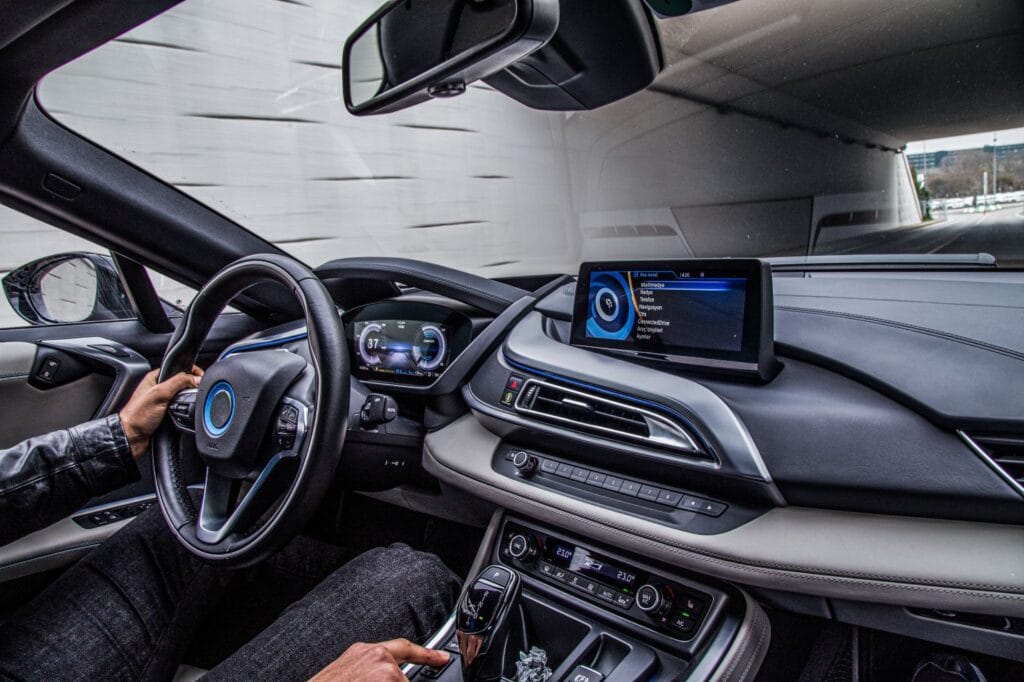
How AI Enhances ADAS Capabilities
Sensor Fusion with AI
Traditional ADAS relied on single-sensor systems, which had limitations in terms of reliability and accuracy. AI-powered sensor fusion combines data from multiple sources such as LIDAR, radar, ultrasonic sensors, and cameras to create a real-time 3D understanding of the vehicle’s surroundings.
For example, it can identify a pedestrian crossing between parked cars which might be missed with a radar or camera.
Real-Time Processing with Edge AI Chips
Edge AI enables computation directly on the hardware of the vehicle which eliminates delays from cloud processing. With the rise of automotive-grade edge AI chips by companies like NVIDIA (Drive Orin) and Qualcomm (Snapdragon Ride Platform), vehicles can perform complex AI tasks instantly.
This allows instantaneous decisions for critical features like:
- Adaptive cruise control
- Automatic lane changes
- Emergency lane departure correction
Emotion AI and Driver Monitoring Systems (DMS)
Emotion AI can monitor drivers’ emotional states using facial recognition, eye tracking, and body movement analysis.
These systems can detect:
- Fatigue or microsleep episodes
- Distraction (looking at a phone, turning head)
- Emotional distress or stress levels
When abnormalities are detected, the system can alert the driver, suggest a break, or even initiate corrective safety measures.
Key Advancements in 2025
Mercedes-Benz Drive Pilot
In 2025, Mercedes-Benz introduced its Drive Pilot system. It combines multiple AI technologies including:
- Gaze detection to ensure the driver is attentive
- Natural voice interaction to control in-car systems hands-free
- High-precision sensor fusion to navigate complex traffic scenarios autonomously (Level 3 driving)
Tesla Full Self-Driving (FSD) Beta 12.x
Tesla’s self-driving software updates are progressing vehicle autonomy on highways and city streets.
Volvo’s Safety Suite
Volvo’s 2025 ADAS suite integrates AI-based predictive analytics that can anticipate sudden braking from vehicles ahead based on their movement patterns.
ADAS is expected to become more affordable and standardized, even in mid-range vehicles shortly. Over-the-air (OTA) updates will allow automakers to roll out new features remotely, improving safety without requiring a visit to the service center.
In-Vehicle AI Assistants Become Standard
In-vehicle AI assistants are voice-enabled systems embedded within a car’s infotainment platform. They function on ML and advanced NLP (natural language processing) algorithms. They allow drivers to interact with their vehicle using conversational language without touching a button or glancing at a screen.
These assistants can understand context, learn user preferences, and take intelligent actions to support a safer drive.
Key Features of In-vehicle assistants
NLP
Modern AI assistants understand complex, human-like voice commands, making it easy for drivers to:
- Adjust climate control
- Navigate
- Control media
Personalized Infotainment
AI assistants learn user habits over time to offer customized experiences:
- Suggest playlists based on time of day or mood
- Recommend podcasts or audiobooks
- Automatically adjust settings (seat position, lighting, cabin temperature) based on driver preferences
Real-Time Route Optimization
- Suggest the fastest or most fuel-efficient route
- Reroute dynamically to avoid delays
- Notify users of nearby charging stations for EVs
Leading Players in In-vehicle assistants
Cerence
Cerence offers automaker-customized AI assistants that support multiple languages and dialects.
Amazon Alexa Auto
Amazon’s automotive version of Alexa connects with your smart home, syncs calendars, and controls entertainment.
Google Android Automotive
Android Automotive is a vehicle operating system that offers deep integration with Google Assistant, Maps, and third-party apps, all powered by Google AI.
AI in Electric Vehicle (EV) Battery Management
EV battery management systems (BMS) enable smarter, safer, and more efficient use of battery resources while improving the overall driving experience.
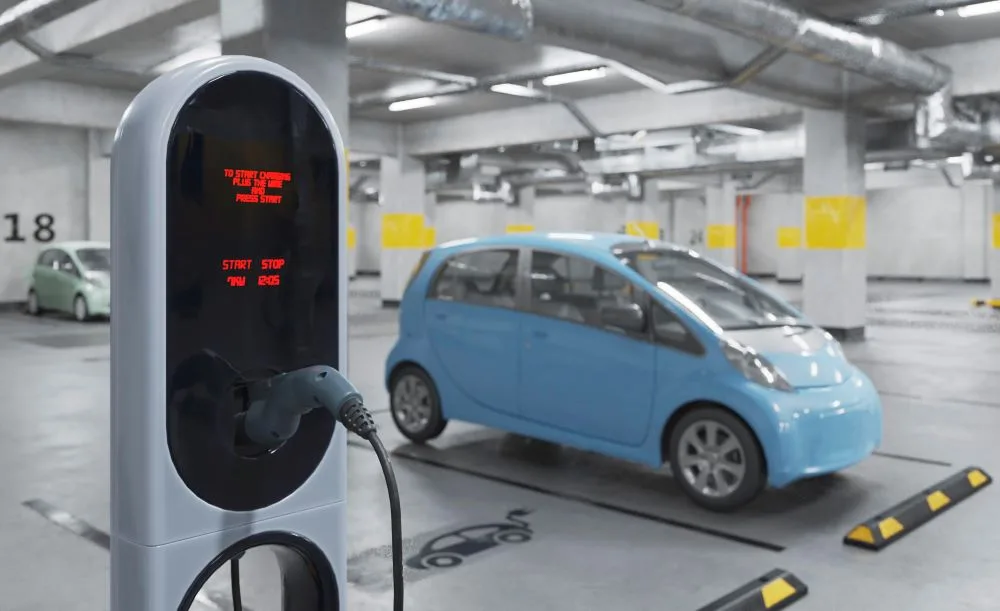
Key AI Trends in automotive in EV Battery Management
Predictive Range Estimation
AI-driven systems analyze:
- Real-time traffic conditions
- Driving patterns (e.g., aggressive acceleration)
- Terrain and weather data
This leads to highly accurate range predictions.
Intelligent Charging Algorithms
AI optimizes charging by:
- Choosing the best time to charge
- Managing fast charging without overheating
- Learning the driver’s schedule to pre-condition the battery for maximum efficiency
This reduces charging time, minimizes energy waste, and extends battery life.
Battery Health Monitoring
AI continuously monitors temperature, voltage, and cell activity to:
- Identify early warning signs of battery failure
- Balance cell loads to prevent uneven wear
This helps manufacturers and fleet operators prevent costly battery replacements and improves overall safety.
Companies Leading the Charge
- Tesla: Uses AI for real-time thermal management, range prediction, and supercharger routing through onboard neural networks.
- NIO: Applies machine learning to optimize battery swapping and smart charging across its network.
- Rivian: Combines predictive analytics to monitor individual cell performance and adjust charging behavior dynamically.
According to a 2025 Bloomberg NEF report, integrating AI into EV battery systems can extend battery lifespan by 30%.
Vehicle-to-Everything (V2X)
This is one of the recent AI trends in the automotive industry. V2X stands for Vehicle-to-Everything, including the following types of communication:
- V2V (Vehicle-to-Vehicle): Directions, speed, and position data are shared between cars
- V2I (Vehicle-to-Infrastructure): Cars interact with traffic signals, road signs, and construction zones
- V2P (Vehicle-to-Pedestrian): Vehicles detect nearby pedestrians via smartphones or sensors
- V2N (Vehicle-to-Network): Cloud communication for updates, navigation, and data transfer
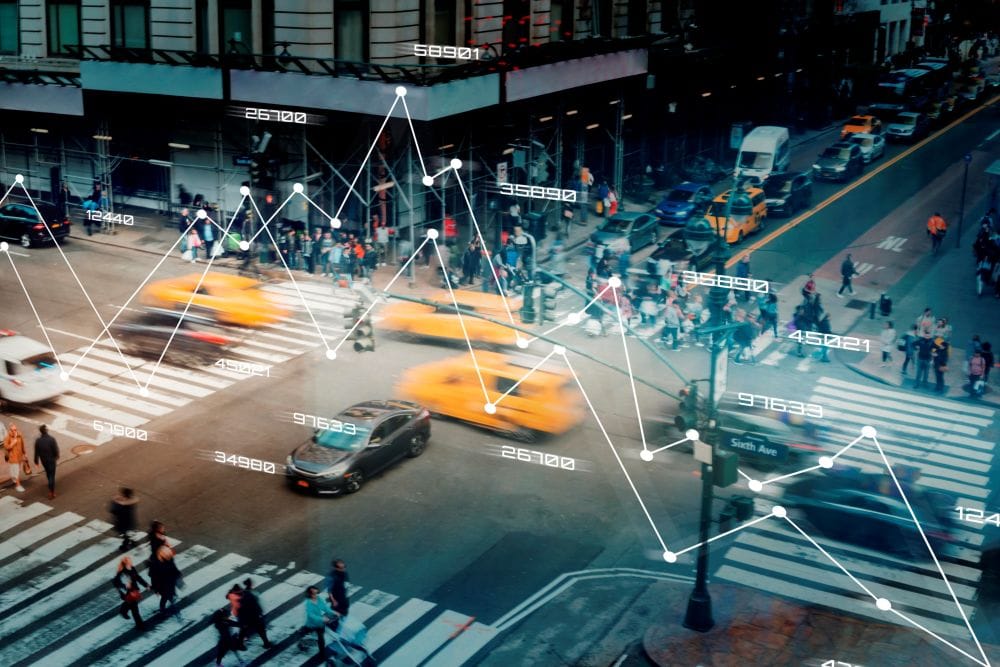
How AI Enhances V2X Systems
Improved Traffic Flow Through Predictive Analytics
AI algorithms analyze V2X data in real time to:
- Optimize traffic signal timing
- Reduce traffic through rerouting
- Predict traffic jams before they form
This results in reduced travel time, lower fuel consumption, and fewer emissions.
Enhanced Road Safety with AI-Powered Hazard Detection
Using sensor data from multiple vehicles and roadside units, AI can:
- Detect accidents or obstacles instantly
- Send alerts to nearby vehicles even if the hazard is around a blind corner
- Coordinate emergency braking between vehicles
What’s on the Horizon?
The next generation of V2X will enable:
- Autonomous vehicle cooperation in real-world urban environments
- V2Grid communication for energy-aware driving
- Augmented reality HUDs showing AI-curated alerts about nearby vehicles and hazards
Personalized AI-Based Insurance Models
Usage-based insurance models calculate premiums based on the amount of driving. By using telematics devices, smartphone apps, or embedded vehicle sensors, insurers collect data on:
- Speed
- Acceleration and braking patterns
- Cornering and lane discipline
- Time of day or night you drive
- Phone usage while driving
- Trip frequency and distance
Algorithms understand this data and prepare personalized insurance quotes.
How AI Transforms Car Insurance
Behavior-Based Premium Customization
Rather than using static metrics like age or ZIP code, AI models adjust rates based on:
- Real-time driving habits
- Seasonal trends and location-specific risks
- Learning patterns that indicate risky or safe behavior over time
This AI trend in the automotive industry provides a highly individualized pricing model, increasing fairness and transparency for consumers.
Fraud Detection and Claims Automation
AI tools help insurers detect difference in claims such as:
- Inconsistent damage reports
- Location discrepancies
- Overlapping insurance claims
According to PwC, AI can reduce claim costs by up to 25% through early fraud detection and faster claims settlement.
Driver Feedback and Coaching
AI-powered dashboards and mobile apps can provide drivers with:
- Weekly driving reports
- Real-time safety tips
- Gamified incentives for safe driving behavior
This creates a feedback loop that promotes safer roads while reducing accident risk.
Insurance Companies Leading with AI
- Allstate – Offers the Drivewise® program, which analyzes real-time driving behavior and rewards safe habits with cashback and lower rates.
- Progressive – Its Snapshot® tool utilizes AI and telematics to monitor driving and tailor premiums accordingly, with discounts for cautious drivers.
- Metromile – Metromile uses AI to analyze trip data and even assist in automated claims processing using sensor and GPS input.
Generative AI in Vehicle Design and Simulation
Generative AI refers to AI systems that can autonomously create multiple design options based on specific constraints, goals, and data inputs. Engineers simply set performance targets (like weight, strength, safety, or aerodynamics), and the AI generates optimized design suggestions in response.
These suggestions are then refined through simulations, which eliminates the need for costly prototypes.
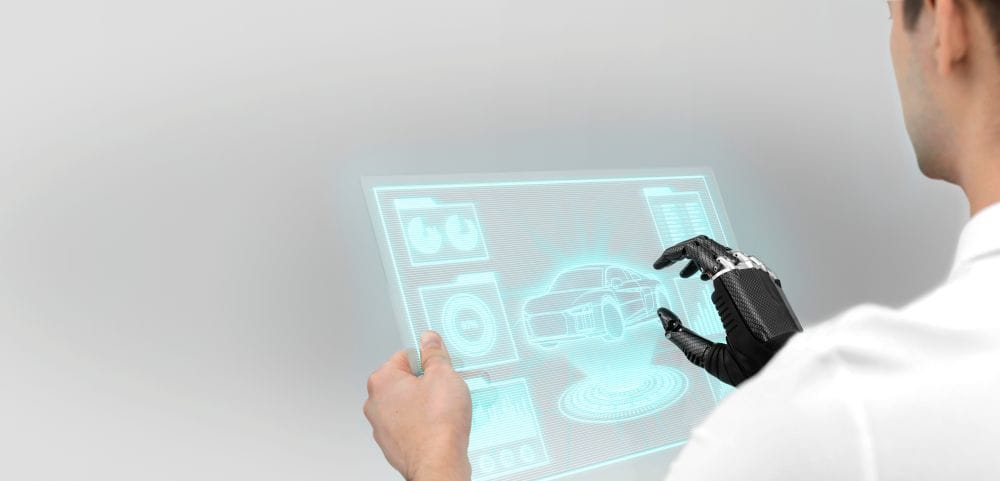
Key Use Cases in Gen AI
Virtual Wind Tunnel Testing
AI-powered simulations replicate wind tunnel conditions in a digital environment, allowing designers to:
- Assess aerodynamic drag and lift forces
- Optimize shapes for fuel efficiency and EV range
- Reduce design cycle times from weeks to hours
Tools like NVIDIA Omniverse and ANSYS Fluent use AI-enhanced physics modeling to make this process accurate and scalable.
Lightweight Material Optimization
Generative AI can identify geometric patterns and materials that maintain structural integrity which is critical for:
- Increasing electric vehicle efficiency
- Improving acceleration and braking
- Lowering emissions in combustion models
Ergonomic Interior Layout Suggestions
AI models analyze human factors data, geometric constraints, and user behavior to optimize:
- Dashboard design and control placement
- Seat positioning for diverse body types
- Interior airflow and visibility
Gen AI Industry Adoption in 2025
- BMW: Uses generative design to create structurally optimized parts that reduce vehicle weight without compromising safety.
- Hyundai: Incorporates AI to redesign chassis and battery casings for better thermal performance and energy efficiency.
- General Motors (GM): Created over 150 optimized part designs using Autodesk’s generative tools.
As Gen AI progresses, we may witness:
- Real-time co-design between human and AI engineers
- Integrated AI simulation with crash testing and compliance checks
- Personalized vehicle interiors based on biometric and behavior data
- 3D printing of AI-generated parts
These are the top AI trends in the automotive sector. Please write to us if you have any questions.
